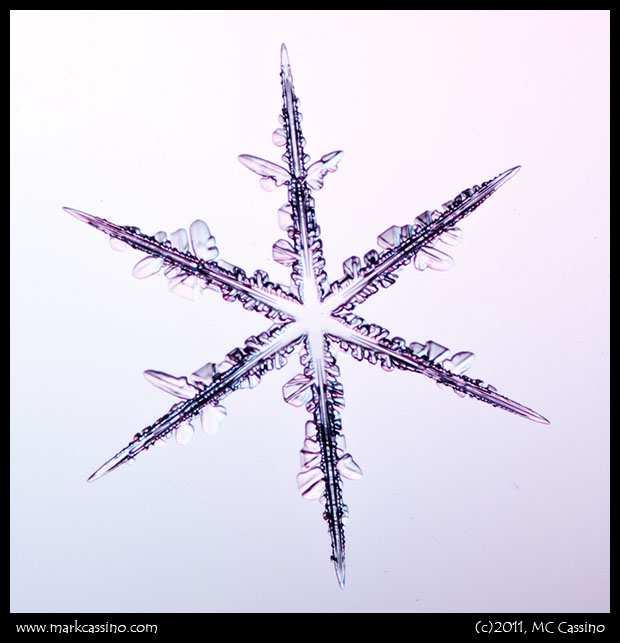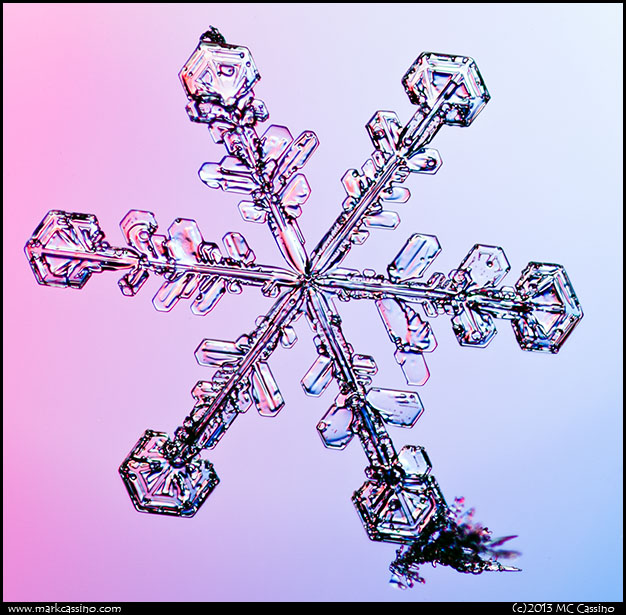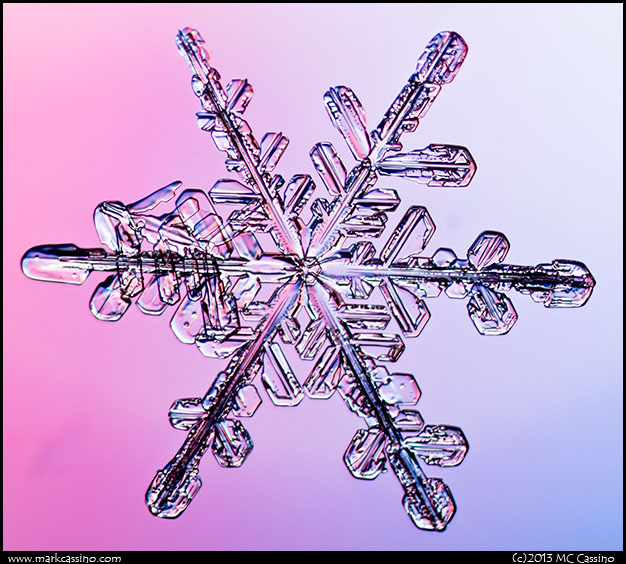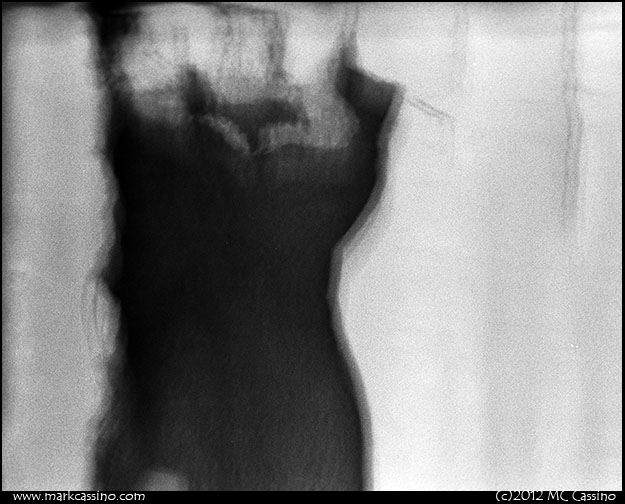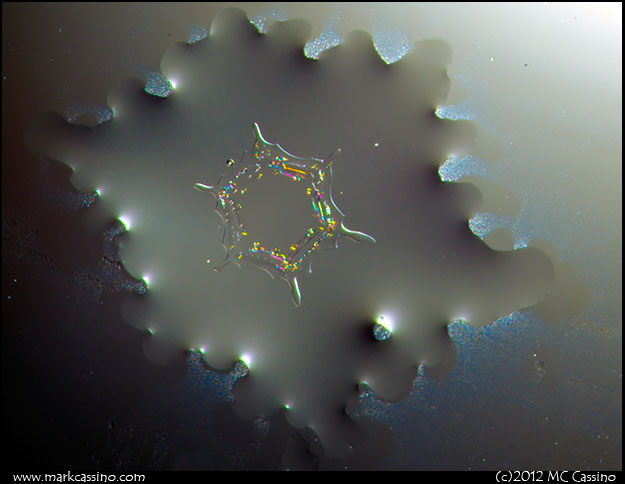Posted by mcc on Jan 26 2013 in Snow Crystal Photography, Snowflake Photography, Pentax K5
Posted by mcc on Jan 20 2013 in Snow Crystal Photography, Snowflake Photography, Pentax Q
A few months ago I bought a Pentax Q system. While this camera is usually criticized for its very small sensor, I saw a tremendous opportunity for macro photography. I really enjoy the camera and use it for a wide variety of purposes with excellent results, but I have been hankering to try some snow crystal shots with it.
Why snow crystals? The sensor on the Q is a diminutive 6 x 4.5mm in size. A large snow crystal would be about that size, meaning that one could get a frame-filling snow crystal image (for a large crystal) at a simple 1:1 magnification, and smaller crystal could easily be photographed at 2:1. This makes for a much simpler setup than what is required for shooting snow crystals on an APS-C DSLR – where magnification needs to be 4:1 to 8:1. The Pentax Q is compatible with all my existing Pentax flash gear and focus peaking should simplify focusing. So I figure I’d give it a try.
So today, when it finally snowed, I tested the Q on my snow crystal macro setup. I usually use a reverse mounted 50mm macro lens (Sigma EX 50mm f2.8) on a bellows (135mm maximum) and extension tubes (180mm maximum). A flash is used to light the crystal from below. I decided to try the Q first with this setup, but just the lens and bellows. Due to how the bellows mount on the macro-focusing lens, they have to be extended to at least 48mm. So, here is a plastic ruler, the metric scale, taken with the Pentax Q and 50mm macro lens reverse mounted on a bellows extended to 48mm. As you can see, the frame covers less than 2 mm on the longer axis. That would be great for many snow crystal shots.

So here is one of my first shots. Not a pretty crystal, but the shot is clear enough:
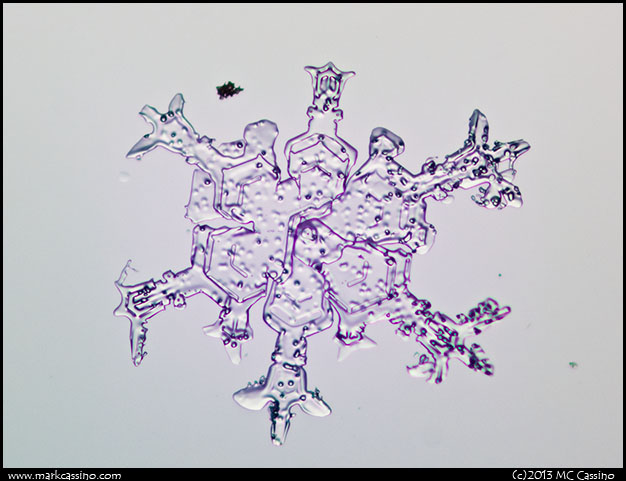
One of the problems I saw right off is that the flash stays in P-TTL mode, even though P-TTL needs access to the lens’s electronic data to function properly. I could not figure out how to get the flash into manual mode, so I just worked with it the old-fashioned way, and put a diffuser over it to manage the power level.
So here is another shot – even at the minimum magnification, the crystal was too big to fit in the frame:

But… What’s that magenta rectangle in the middle of the shot? It can be minimized by desaturating the image, but I don’t like it. Here’s the desaturated image:

So… Plan B – skip reverse mounting and just use a macro lens mounted normally and shoot at 1:1 or 2:1. I tried the DA-F 100mm macro, but the working distances posed a problem with my tripod setup. So, back to the Sigma 50mm. The lens will go to 1:1 on its own and with a 25mm extension tube it will do 1.5:1. So I setup the Sigma 50 mm macro lens on a 25mm extension tube.
An early test - here again the crystal was larger than the 1.25:1 magnification that I had set up the lens for:

Here’s a very “fluffy” snow crystal lit by a flash from below and compact florescent lights from above:

By this time the snow had stopped… So that was it for today’s experiment. I’ll continue working with the Q for this kind of photography – need to work out what is going on with the flash and test some other lenses. I guess that the magenta triangle was some sort of lens flare from the reverse mounted lens, but there is still a bit of it in the shots taken with the lens forward mounted. I have never seen that in shots taken with other cameras (I’ve used this setup with the *ist-D, K-10D, K-7 and K-5.)
As for noise – at ISO 160 there is very little noise. The advantages of the system way out weight the disadvantages.
More experiments to come - assuming it snows some more! At the end of the day, the grass is till poking out of the snow. Less than an inch fell today, but more is coming.
Posted by mcc on Jan 15 2013 in Announcements, Insect Photography, Landscape Photography, Film Processing, Pictures Of Trees, Midwestern Landscapes, Snow Crystal Photography, Snowflake Photography, Around The House, Infrared, Bird Photography, Allegan State Game Area, Allegan Forest, Dragonfly Photography, Macro Photography, Cat Photos, Infrared Converted Pentax KD10, Digital Infrared, Travel, Pentax K5
Folks on the PDML have been posting their 12 best shots of 2012 lately… I’m a little late and can’t say that these are my best shots, but they are my favorites for the year. To make it a baker’s dozen I added an older shot that I finally worked on enough to be happy with in 2012. So here are my 12 for 12 (click on images for a larger file): Snow Crystal (January, 2012):It barely snowed at all here in SW Michigan in 2012, but I managed one nice crystal shot in early January:

Spring Colors (March, 2012):Why wait for fall for foliage colors? Spring tree blossoms and buds captured on color film wiht the Pentax 6x7:
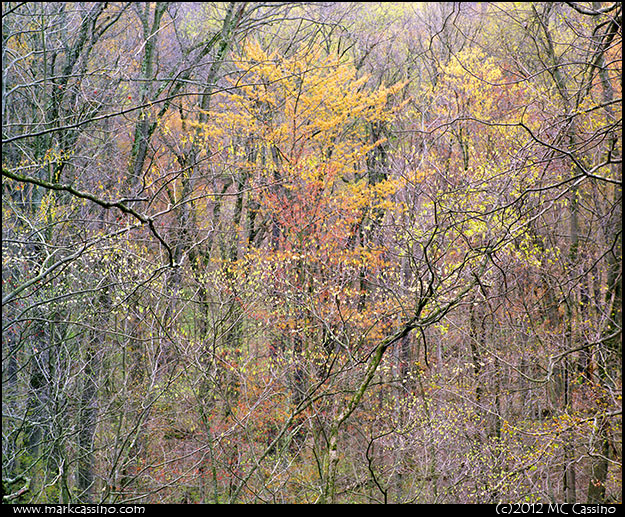
Around the House (April, 2012):My boy Jazz - psycho cat Qu’est-ce que c’est? Made with a Pentax LX and Kiron 105mm f2.8 macro lens on Fuji Neopan 400, rated at 400. Developed in D76 1+1.

Jumping Spider (May, 2012):Pentax K5 and A* 200mm macro:
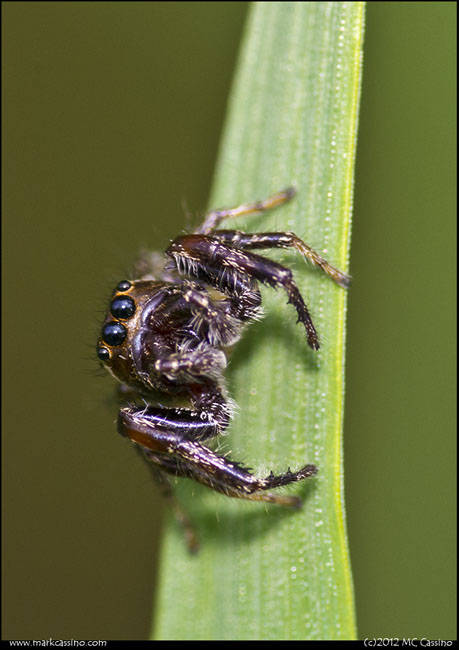
Ebony Jewelwing (May 2012):A common but elusive damselfly. Pentax K5 and A* 200mm macro:

The Jewelbox, St. Louis, Missouri (June, 2012):Sort of a street photo. Infrared converted Pentax K10d:

Gateway Arch in Infrared (June, 2012):Speaking of St. Louis… note the troop of Boy Scouts in the lower left corner, best seen in the larger file.

Visitation #1… (April, 2012) If these photos were music they would be pop songs…. nothing wrong with that but sometimes you want to really rock out. So I started the Visitation Project in the spring of 2012. Pentax LX, Kiron 100mm macro, Neopan SS pushed to 200 and souped in D76 1+1:
Dashing Blue Dasher (August, 2012):Ever a favorite Dragonfly - the drought this year really hit the mid and late summer species, so the Blue Dashers hung around for a long time.

Finches and Thistle (August, 2012):I let a few bull thistles grow in my wildflower garden and the goldfinches loved them. Here’s one munching on the seeds. Pentax K5, A*400 f 2.8, SMC 1.7x AF converter:

Pastoral Scene (September, 2012):I traveled to central Indiana a lot in the last few months of the year and bought a Pentax Q kit in late August to take on the road with me. Marvelous camera - a shot from my tavels:

Autumn Colors (October, 2012):2012 brought a beautiful fall to West Michigan and I managed bump into it one October morning. Pentax K5 and DA 16-45 f 4 zoom:

Baker’s Dozen: The Shady SpotTaken in 2010 and worked on since then, I finally made a photo from this exposure that I like. I could say that I really like it. Pentax LX, fa 20-35mm F4 AL lens, Rollie 400 IR film, Hoya R72 filter.

Posted by mcc on Mar 04 2012 in Snow Crystal Photography, Snowflake Photography
“I’m melting! Melting!
Oh, what a world! What a world!”
– Wicked Witch of the West
In a winter as warm as this, every snow is like the first snow. Wet flakes land on warm ground, melting on the sidewalks and streets but sticking on the grass. Last night’s snowfall proved to be no exception, as the temperature outside hovered just a few degrees below freezing… And inside the garage where I shoot snow crystals, the residue of the last few warm days kept the temperature right at the freezing point.
Well, at least it was snowing… I tried a few shots and the snow crystals quickly melted, before I could take any photos. Back in December, 2009, I took an usual shot of a snow crystal just as it melted away - or maybe it was a photo of a drop of water, just as it emerged from a crystal. I don’t remember… Well, with all these melting crystals, maybe that is something to try again…
So - here is one of the first shots of the evening - a rather nice stellar dendrite that had already begun to melt when I snapped the first image of it. Here’s the first shot, where the structure is still more or less intact -
(With all images - click for a larger view.)
Here’s a shot about 45 seconds later - the last wafer thin remnant of the crystal floats on (or presses into) the drop of water, which is the melted remain of the rest of the crystal…
Well, that’s interesting. I tried some more… Here the lingering remnants of a crystal’s heart twinkle with color. It was a large dendrite that melted before I ever got the glass plate beneath the lens. I speculate the some sort of partial dark field effect accounts for the colors.
Maybe the same thing happened with this shot -
There was no opportunity to tweak the lighting for these shots - in a manner of seconds the crystals melted away to nothing. Here is another crystal that I was able to capture just as it was starting to melt - the lighting is so dead-on that it looks virtually like a B&W shot:
The crystal was not well formed, and even in the first shot it was melting in the upper right. About half a minute later, it looked like this -
Finally - the bones of two crystals that melted together, floating on their co-joined watery remains:
Posted by mcc on Jan 16 2012 in Snow Crystal Photography, Snowflake Photography
This winter is turning out to be disappointing. We’ve had day after day of warm temperature, often barely dropping below freezing even in the evenings. What little snow we have gotten has been sloppy an d mixed with rain.
Last weekend we finally had a hard snow and a true blast of cold weather. While the detached garage in which I take these snow crystal photos had cooled down a bit, it still took till the next morning to finally drop below freezing inside the structure - even though it was well below freezing outside.
And so on Saturday morning I set up the camera and managed to get one, just one, snow crystal photo. The snow stopped just as I set up the rig and prepared to start photographing. Here’s the one photo I did get - click for larger version.
And here we are - another warm day and rain on the way. Maybe more crystals will come soon…
Posted by mcc on Dec 14 2011 in Snow Crystal Photography, Snowflake Photography
Note: This post originally appeared in the Story of Snow’s blog - www.storyofsnow.com - on February 17, 2010. Since many these photos have not appeared here before, I’m reposting it here in Calarti.
And besides - it’s 55F and raining on this particular December evening, so no snow crystal photos in the near future this winter!
If you are interested in the classification system, checkout Jon Nelson’s original post on the subject which can be found here.
February 17, 2010:
I found Jon’s post regarding the Magono-Lee Snow Crystal classification system to be quite interesting. Here are some more shots from Monday night - I’ll see if I can classify them… something tells me that will be more difficult than it sounds.
Let’s start with something simple. My first guess is that the two crystals that follow would be classified as P2d - Dendrite with Sector-like ends:

It looks like that crystal bumped into a couple of simple plates along the way, and they are stuck to it in the lower right quadrant.
The one below has one spot of rime on it - which I assume is not enough to knock it into the rimey category, so it too is a P2d:

This one is similar in general form to the one above, but has a bit of rime spotting it up. I guess it would fall under rimed stellar R1d under Magono-Lee’s system. Personally, I think it would make more sense to have rime as a qualifier of the basic shape, so if I was cooking up a classification scheme I’d call this a Dendrite with Sector-like ends with moderate rime. Maybe P2d-r2.

The next one is a 12 branched crystal without rime, so it is either a P4a (broad branched with 12 branches) or a P4b (dendrite with 12 branches.) Personally, I’d call it a 12 branched variant of the P2d formation, which we just saw above. Maybe P2d-2x? Well - under the existing system it is either a P4a or P4b…

You may have noticed what looks like a sectored plate emerging from one arm at about the 8 o’clock position - that appears to be a growth at the end of that arm.
OK - let’s get back to something simple. I think the following are all ordinary dendrites - P1e.
This first one has a ‘crack’ in the center plate - something I’ve seen several times. I’m not sure what causes it.


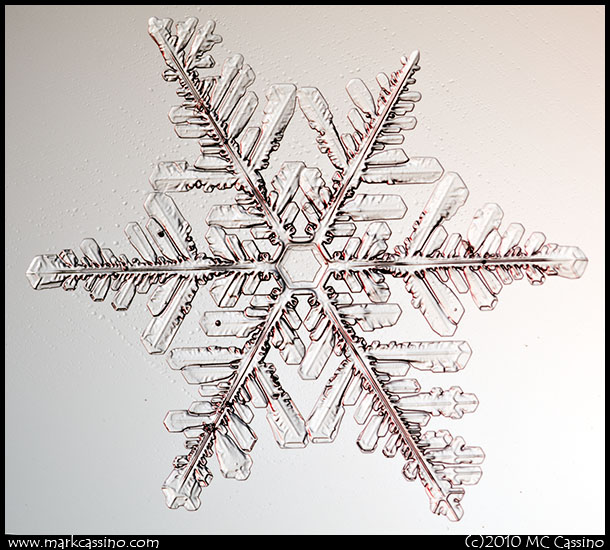
And I’ll close out with three rimey subjects, the first two would be R1d - Rimed Stellar and, I think, the last one would be R2b - Densely Rimed Stellar. Though one might think it was a densely rimed fernlike stellar dendrite - maybe P1f-r3, eh?



Magono-Lee is an interesting classification system. I don’t understand exactly why it places such an emphasis on rime at the expense of the core structure of the crystal. It seems to me that rime is an incidental condition independent of the core structure of the crystal. Classifying rimey crystals as a distinct group is sort of like lumping all molting birds into a distinct group. But just as Nietzsche observed that histories reveal almost as much about the historians who wote them as about actual past events, I’d speculate that classification systems tell us a bit about the people who developed them as well as the subjects being classified. Maybe rime was important to Magono or Lee…
Posted by mcc on Feb 22 2011 in Snow Crystal Photography, Snowflake Photography, Macro Photography
Here are a few snow crystal photos from the Groundhog Day blizzard of 2011 - I posted these on the Story of Snow blog a while back -



Posted by mcc on Jan 17 2011 in Snow Crystal Photography, Snowflake Photography, Nature Notes
Here it is, bleak mid winter. The skies are gloomy and grey and days pass without a hint of sunshine. A little snow covers the ground. It is cold.
It snows, now and then, and I’ve been going outside to take snow crystal photographs. But the snow is opaque, dusty, and effervescent. Hours spent collecting snow crystals result in only mediocre images, as all the crystals are broken, odd or irregular.
The other night, after a few hours of collecting and discarding snowflakes, I realized just how selective this whole process is. The snow crystals I decide to display are the most regular and symmetric of the snow crystals I choose to photograph, which are the most regular and symmetric of the ones I gather. It seems that the vast majority of the crystals actually flying around in the air or landing on earth are irregular or broken, odd and ugly. I ignore them and focus attention on a small percentage that flatter my construct of how snow crystals really should be. Nature speaks with a loud and clear voice, but I hear only one word out of a thousand, and misunderstand even those.
Hmmm… Too much time spent out in the cold. Here are a few shots from the last couple of weeks:
